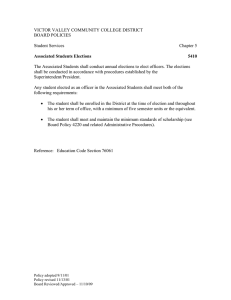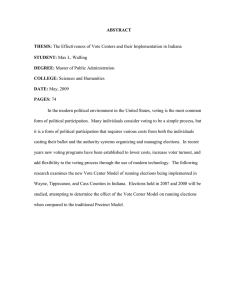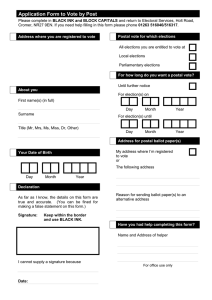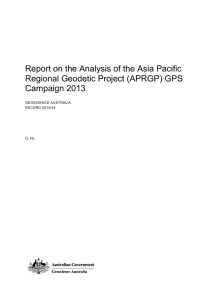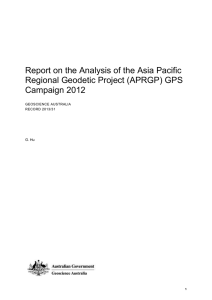Power Point Presentation of the paper
advertisement
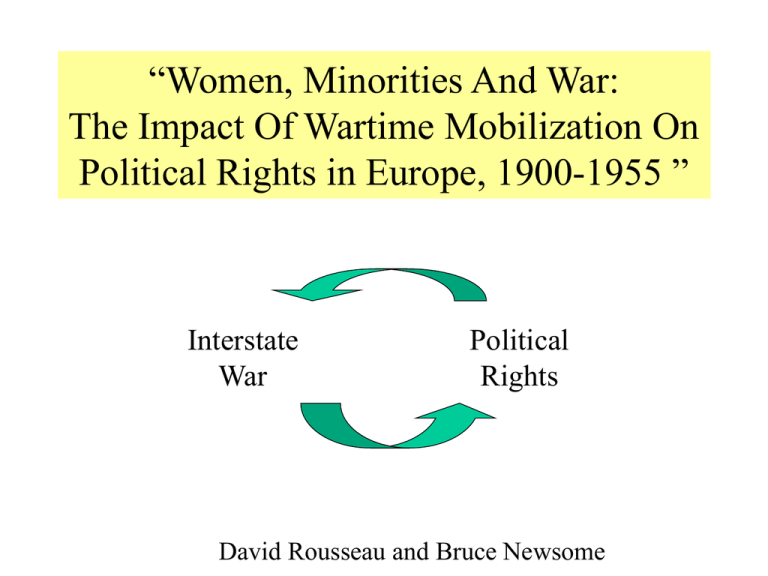
“Women, Minorities And War: The Impact Of Wartime Mobilization On Political Rights in Europe, 1900-1955 ” Interstate War Political Rights David Rousseau and Bruce Newsome Relationship to Prior Work Project #1 Democracy and War: Forthcoming Stanford. Democracy Project #2 “Identifying Threats and Threatening Identities”: Under Review. Shared Identity Project #3 Military Conflict and Political Rights Military Conflict (-) (-) War Threat Perception Democracy Identity Conflicting Hypotheses Tilly: War Made the State. But What Type of State? • Garrison State School War (-) Political Rights • Extraction School War (+) Political Rights Impact of War on Specific Groups Direct vs. Indirect Participation Majority Females Males Minority Males Measuring Political Rights • Individual Rights I) Right to Hold Office II) Right to Form Political Parties III) Right to Vote in National Elections IV) Freedom of Expression • Collective Rights I. Free and Fair Elections II. Legislative Power Over the Executive III. Rule of Law IV. Military Intervention in Society Code for Majority Males, Women, and Minority Males Example of Political Rights Coding Rules III) Right to Vote in National Elections: 3) Unrestricted: All adults in the sub-population have the right to vote in national elections. 2) Slightly Restricted: Although most adults have the right to vote in national elections, there are some restrictions. These restrictions affect no more than 20% of the sub-population. 1) Substantially Restricted: The right to vote in national elections is severely curtailed. Due to numerous types of restrictions, the percentage of the sub-population eligible to vote in national elections falls between 20% and 80%. 0) Extremely Restricted: The right to vote in national elections is restricted to less than 20% of the sub-population. Research Design • New Data Set: 24 European States, 1900-1955 • Measuring Military Conflict a) Cumulative Battle Deaths and Number of Militarized Disputes b) Lagged Troop Mobilization • Competing Explanations a) Domestic & International Suffrage Movement b) Diffusion of Ideas c) Economic Development d) Power of the Left in Society Bivariate Results: Collective Rights Free and Fair Elections ------------------------------------------------------Decreased No Increased Rights Change Rights --------------------Peacetime 2% 97% 1% Wartime 8% 89% 3% Just After War 4% 88% 8% N=1141; Chi Square (4)=47.0; Probability = .000 Similar: Rule of Law, Legislative Power, and Military Intervention Graphical Results: Individual Rights Dependent Variables: Cumulative Battle Deaths. Model 1 Females Model 2 Minority Males -0.002 0.001 *** Lagged Mobilization 8.801 5.533 * 21.587 6.974 *** 10.339 6.363 * 3.358 8.489 Strong Domestic Movement 3.648 0.680 *** 3.764 0.942 *** 2.426 1.044 ** 4.212 1.147 -0.377 0.558 0.987 0.889 0.619 0.712 0.709 0.823 1.493 0.811 ** Model 4 Collective Rights -0.003 0.001 -0.002 0.001 IAW Attendance *** Model 3 Majority Males -0.001 0.001 4.361 0.804 Progressive Social Programs 0.327 -0.018 -0.250 -0.064 0.273 0.365 0.392 0.417 ** -0.107 0.948 1.293 1.291 0.819 0.948 1.154 1.197 Catholic 1.521 0.845 Nationalist Struggle 0.363 -0.506 -1.873 0.665 0.991 1.034 1.037 0.0002 0.0002 0.0004 0.0003 0.0003 0.0002 0.0004 0.0003 -0.0001 0.0002 -0.0002 0.0002 -0.0002 0.0002 -0.0003 0.0002 -0.905 0.778 -1.080 0.889 -1.522 0.737 1.771 1.648 Iron and Steel Production Urban Population Occupied During War ** Occupied by Democracy 3.426 1.546 ** 2.464 1.625 Constant 1.472 0.397 *** 5.646 0.934 Number of obs F( 12, 23) Prob > F Adjusted R-squared Number of clusters 1079 42.5 0 0.51 24 1079 9 0.0 0.25 24 * *** 8.007 0.888 1079 9 0.0 0.17 24 *** 0.529 0.698 Neighborhood Diffusion *** *** ** ** *** -0.333 * -2.241 0.916 *** 3.111 1.295 *** 7.240 1.299 *** 1078 40 0.0 0.26 24 Conclusions • Conclusions: 1) During War Political Rights Contract 2) After High Mobilization Political Rights Expand 3) Direct Participation by Women Not Required • Future Research 1) Expand the Spatial & Temporal Domain 2) Greater Differentiation of Minorities 3) More Sophisticated Modeling of the “J-Curve” 4) Case Studies and Oral Histories OLD SLIDES BELOW Relationship to Prior Work Project #1: Democracy and War: Institutions, Norms, and the Evolution of International Conflict. Forthcoming Stanford. Project #2: “Identifying Threats and Threatening Identities: The Social Construction of Realism and Liberalism.” Under Review. Project #3: Military Conflict and Political Rights War and State Building Technological Innovation in Warfare Tactical Innovations in Warfare Expansion in the Size of Armies Mobilize Fiscal Resources: Expand Tax System Desperate Need for Revenue Mobilize Human Resources: Recruit Mercenaries and later Conscripts Expand Coercive Apparatus

